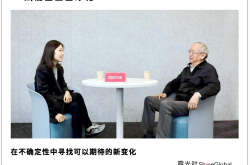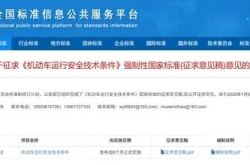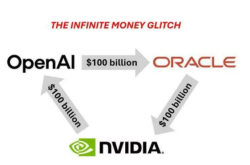Why Are Popular Business Districts Like Solana Blue Studying Douyin?
![]() 11/17 2025
11/17 2025
![]() 432
432

Editor | Sun Jing
As the "original internet celebrity" in Beijing's commercial real estate landscape, Solana Blue carries the aesthetic memories and commercial ideals of the economic upswing period.
Adjacent to Beijing's "Seine River"—the Liangma River—and Chaoyang Park, this 220,000-square-meter architectural complex replicates European charm on a scale about one-third that of the Forbidden City. It serves as a melting pot for diverse groups: high-net-worth families and young professionals within a three-kilometer radius, international friends from the Third Embassy District, tourists flocking to the "3A-rated scenic spot," and young people enjoying Citywalks. They find joy in shopping, strolling with kids, feeding pigeons, dining at Michelin-starred restaurants, and appreciating art exhibitions and light shows.
As people grow more accustomed to these scenes, places like Solana Blue face new challenges. In Chaoyang District alone, Solana Blue competes with over a dozen commercial complexes—including Hopson One, Sanlitun, Chaoyang Joy City, China World Mall, and SKP—for a limited customer base. Zheng Zhelun, Deputy General Manager of Solana Blue, told NoNoise: "The biggest challenge for business districts currently is increasing homogenization." With ever-diversifying shopping options, how can business districts continuously stimulate new vitality and attract both new and returning customers?
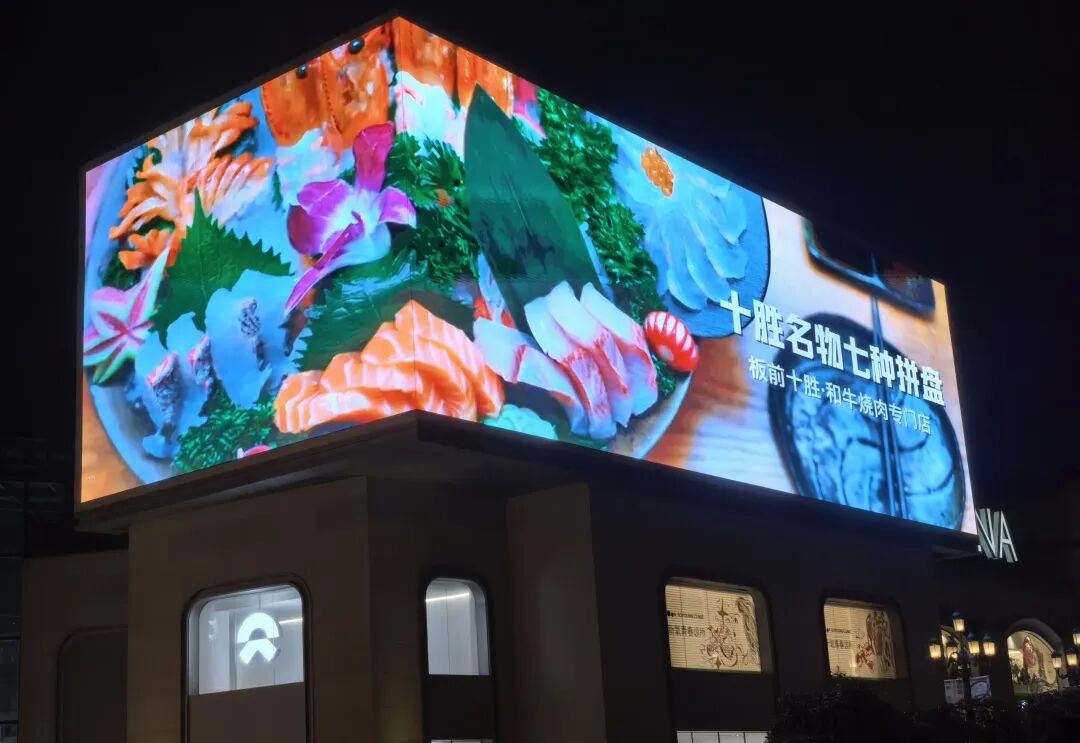
▲Merchant short films played at Solana Blue
Several months ago, Solana Blue explored new possibilities through a bold "scene recreation." The naked-eye 3D screen at Tongqiu Square shifted from displaying celebrity endorsements to looping promotional videos for Douyin's "Crush List" restaurants, produced by the original team behind "A Bite of China." The West Bank Dining Street was adorned with standees and promotional materials featuring brand ambassador Yang Zi. At the Cupid Square, a "Crush"-themed starlight concert immersed both onsite audiences and online viewers in love songs. As the music faded, crowds dispersed to nearby restaurants.
From an industry perspective, traditional strategies to break out often involve introducing youth-oriented content like "secondary culture" or creating scarce resources through "first launches/exclusive stores." What other methods can drive traffic? Solana Blue offers its answer. Since the latter half of this year, similar scene transformations have unfolded in popular Beijing business districts like Hopson One and Huaxi LIVE·Wukesong.
01
Popular Business Districts Seek to Break Out
As a typical street-style business district, Solana Blue offers shopping and recreational experiences, with a laid-back atmosphere perfect for viral video content. In Solana Blue's official Douyin livestream room, whenever the host embarks on a "food-and-stroll" livestream—walking along the street, sampling dishes, and demonstrating take a photo (photo-taking) poses at scenic spots—the livestream interaction surges by effectively conveying the district's spatial charm and dining experiences to users on the other side of the screen.
Previously, the "Liangma Food Street" by the Liangma River and the international dining bars near Chaoyang Park gained fame primarily through merchant-led "grass-seeding" (recommendation) efforts driven by transactional goals. In contrast, Solana Blue's livestream room, operated from the business district's perspective, emphasizes the overall ambiance of the offline scene, offering a fresh experience to many netizens previously unfamiliar with Solana Blue.

▲Solana Blue's "Qixi Festival" special livestream
To drive offline traffic, business districts spare no effort: In the livestream room of Beijing DT51, a high-end community department store under Hualian Group, a Michelin-starred chef cooks Yangzhou fried rice and slices Peking duck on the spot, eliciting comments like "I'm getting hungry" and "Looks delicious" in the chat. Targeting high-net-worth families in the Asian Games Village and surrounding areas, Beijing DT51 prioritizes quality and experiential scenes. Showcasing a Michelin chef's focused culinary skills resonates more with this demographic than a simple "3-2-1, shop now" approach.
Meanwhile, in Hopson One's livestream room, which features a food court, the host keeps things straightforward: after a brief greeting, they immediately distribute coupons. This approach appeals more to cost-conscious young consumers.
Since this summer, well-known offline business districts in Beijing have accelerated their layout (layout) of Douyin livestreaming. Unlike isolated merchant livestreams, official business district accounts integrate scattered merchants into a virtual "super brand," aggregating and sharing customer traffic within a single livestream room.
Using official accounts as the main battlefield, they attract users through customized livestreams and leverage offline events to generate buzz, creating a virtuous cycle from online grass-seeding to offline experiences and back to online sharing.
In terms of business models, whether through fixed rents or revenue sharing, shopping mall operators and their merchants are inherently interdependent—their fortunes rise and fall together. Finding sustainable growth for merchants has always been the goal of business district operators.
From a business perspective, the pursuit of growth revolves around two core objectives: expanding the customer base or increasing per-customer value. However, traditional offline commerce is constrained by physical space, with a typical Radiation radius (radius) rarely exceeding 3-5 kilometers. In today's highly online-driven consumption decision-making environment, even top-tier business districts face the challenge of reaching broader audiences.
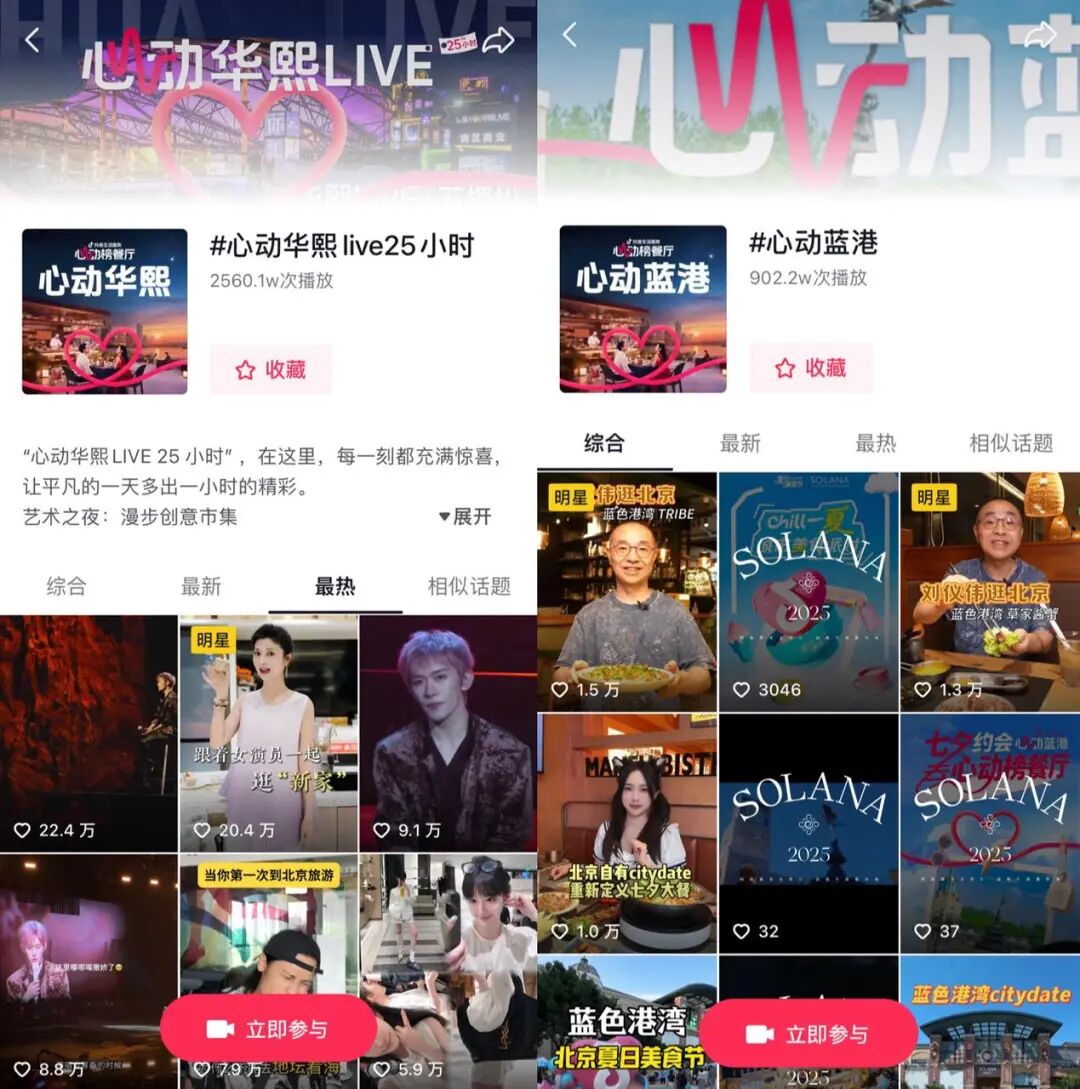
▲#CrushHuaxiLIVE25Hours and #CrushSolanaBlue topic pages
Livestream rooms bring the complex offline experience to the forefront of users' decision-making process, becoming a pivotal factor in "where to consume." While physical spaces have boundaries, online lifestyle platforms amplify and extend a business district's "space," enabling 24/7 exposure. Moreover, when users search for a business district's name on Douyin, they encounter a dedicated topic page integrating content, products, and events—essentially a free additional channel for traffic exposure.
According to sources, savvy business districts value not only Douyin's traffic but also the top-tier "resources" the platform can mobilize. Examples include commissioning the "A Bite of China" team to produce documentary-level TV commercials, inviting top influencers for store visits, and collaborating with celebrity Yang Zi. These high-quality resources, aggregated by Douyin, drive significant exposure and transform how business districts "tell their stories."
02
"Content + Field":
Prioritizing Users in Business Districts
In the past, business districts relied solely on location and merchant recruitment to convey physical "scarcity" value. Today, they also emphasize vibe and lifestyle—a shift from focusing on "store management" to balancing "content management." To break beyond the immediate 5-kilometer radius, business districts focus on integrating online and offline scenes, essentially returning to a customer-centric perspective.
For consumers, individual merchants typically fulfill isolated needs like "having a meal" or "watching a movie." Business districts excel in integrating resources from the consumer's viewpoint, combining dispersed scenes like "dining, strolling, entertainment, and photo-taking" into a holistic, immersive lifestyle experience with corresponding consumption solutions.
To this end, Douyin's lifestyle service platform not only aggregates merchants and high-quality grass-seeding content online but also introduced the "Privilege Card" product. Take Huaxi LIVE·Wukesong as an example: during the National Day Golden Week, it launched exclusive privilege cards priced at 168/228 RMB, offering choices like one main course brand, one beverage brand, and multiple options for comprehensive leisure and entertainment services. Users could freely mix and match among main courses, beverages, and leisure activities, truly achieving "one card to explore the business district."
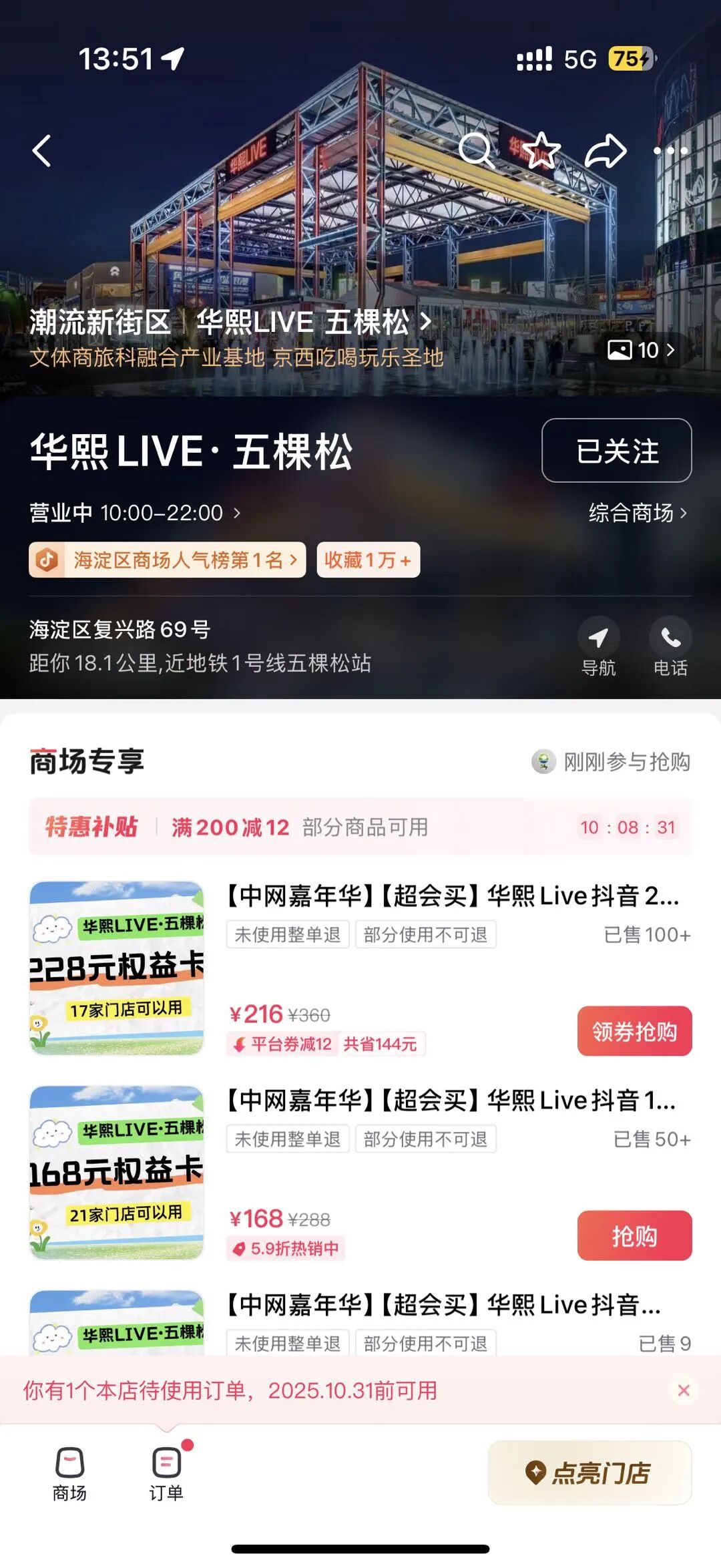
▲Huaxi LIVE·Wukesong's trial launch of the "Privilege Card" during National Day Golden Week
During the event, the privilege card drove a 1414.71% month-over-month increase in exposure for the group-buying mall. This model was later implemented in business districts like Wangfujing, Sunac, Longfor Tianjie, and R&F Plaza, with privilege card package sales surpassing the million-RMB mark.
Additionally, young consumers seek not just products and services but also emotional value to share and assert their identities. Shopping centers compete by introducing "aesthetic dining," "merchandise (guzi)," and numerous content-driven events and exhibitions, aligning with this trend. The current trend of "group livestreaming" among business districts stems from the same consumer insight—the realm where the "content + field" model thrives.
Since summer, offline business districts and Douyin have gradually formed a replicable "model": by jointly planning online-offline events, they transform online traffic and content into immersive offline experiences that are perception (perceptible), participate (participatory), and spread (shareable).
For instance, Huaxi LIVE·Wukesong collaborated with Douyin during summer to launch "Crush Huaxi LIVE·25 Hours." They created a "Crush Restaurant Market" featuring over 30 merchants to gather crowds; hosted a "Find the Undercover Duck" event with the B.Duck IP to attract families; and leveraged the "Liu Yu Concert" by offering ticket giveaways a day prior, boosting customer traffic by 30% week-over-week. During this period, Huaxi LIVE·Wukesong's POI (Point of Interest) ranking on Douyin's local feed surged from 10th to 3rd in Beijing. Business district backend data revealed a high influx of new high-net-worth customers, with strong retention and per-customer spending.

▲Solana Blue's "Starlight Concert" live event
Solana Blue teamed up with Douyin to host a Qixi Festival event around the popular IP "Starlight Concert." Zheng Zhelun noted that the romantic festival atmosphere boosted customer traffic by over 20% that day. Hopson One collaborated with Douyin and over 200 stores in its B1 and B2 "21 Block"—including ramen, fried skewers, and rice toppings—to launch the "Qixi Date at Hopson One" campaign. By rebundling scattered consumption scenes into a "festival event" and distributing coupons via livestream, conversion rates soared.
From the outcomes, these events transcend simple promotions, evolving into highly social "check-in events" through meticulous content planning. Rather than emphasizing "lowest prices online," they highlight "unique experiences of the moment." By embedding consumption into specific, emotionally charged life scenes, they significantly enhance the psychological premium of transactions, making consumers willing to pay for ambiance, social interaction, and instant joy.
03
From Business Districts to Urban Life Circles
The explorations by Solana Blue, Huaxi LIVE, and others offer digital operation insights for other business district operators. The core of this model can be summarized as: using official accounts as the operational base, customized livestream content as the driver, and offline events as the catalyst, ultimately forming a complete loop from online grass-seeding to offline experiences and back to online content.
Of course, the true catalyst for consumer mindshare remains the business district's own healthy operations and merchant brands' quality services. On this foundation, a "synergistic effect" emerges between the district and the platform. While individual merchants' brand perceptions are fragmented, when the entire district unifies under a theme and collaborates with Douyin across online and offline channels, customers' perception of the district's brand amplifies, along with recognition of its quality merchants.
Users might be drawn to Solana Blue by a concert video on Douyin or convinced to try new dishes at Hopson One by a food blog. Conversely, business districts use this content and data to better grasp consumption trends and optimize their merchant mix. A virtuous cycle driven by "people-content-field" thus forms.
This implies that future evaluations of a business district's value will adopt more diverse criteria. Beyond traditional factors like location and occupancy rates, online presence, content creativity, and aggregated online user resources will become equally vital metrics.
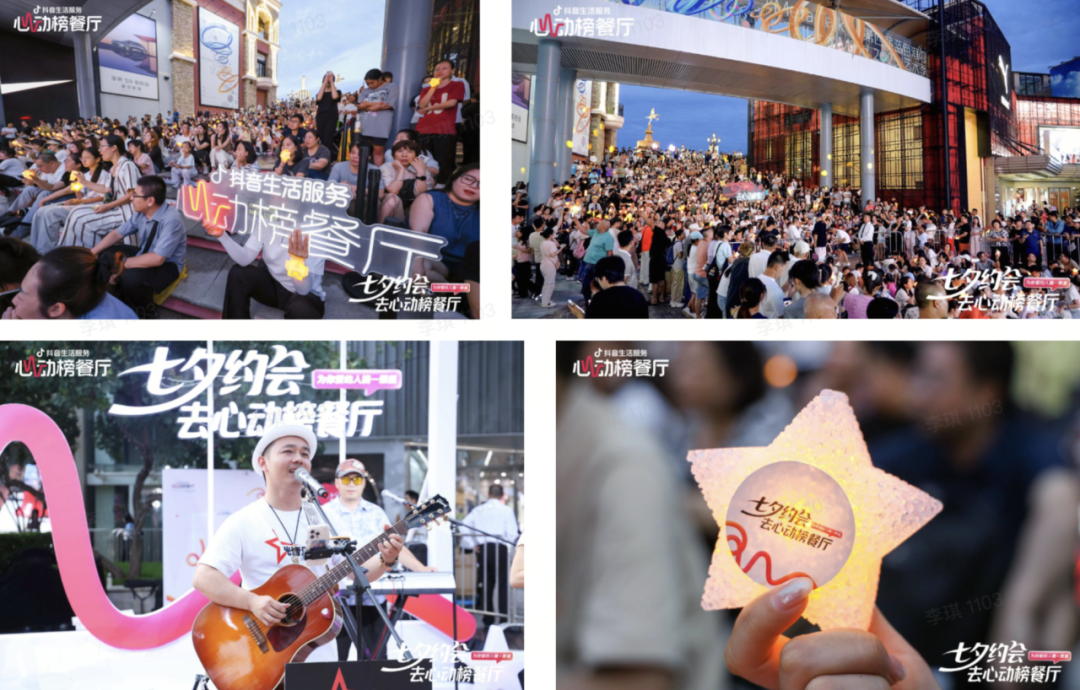
▲Achieving "stroll + dine + concert" at Solana Blue
Many business districts have long recognized the online-driven "expansion" value for offline spaces. However, integrating the two is fraught with uncertainty, and trial-and-error approaches risk prematurely concluding that "online efforts are futile." Instead, following the lead of Solana Blue and others by leveraging Douyin's content management strengths to explore a tailored "content path" may prove more effective.
From a business standpoint, this is also an efficient route for Douyin to expand its local lifestyle services. By partnering with business districts, the platform can rapidly reach numerous brands (especially premium merchants) previously difficult to engage, enriching its merchant ecosystem. A Douyin Lifestyle Services representative noted that when the platform brings in the "A Bite of China" team for merchant TV commercials, district managers and store owners feel an unprecedented sense of respect and professionalism—a sincerity that fosters collaboration with high-quality clients.
This online-offline synergy is also redefining the relationship between business districts and cities. No longer isolated consumption venues or mere physical landmarks, they evolve into interactive, culturally rich urban life circles—potentially becoming city super-IPs. In a sense, an online-offline interactive concert or a "one-day business district tour" package bundling dining and entertainment could mark the next phase of offline business district evolution.

